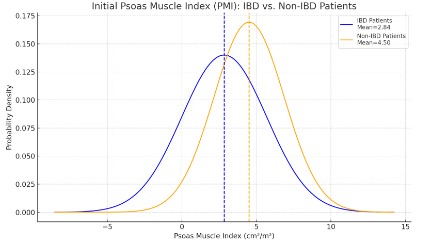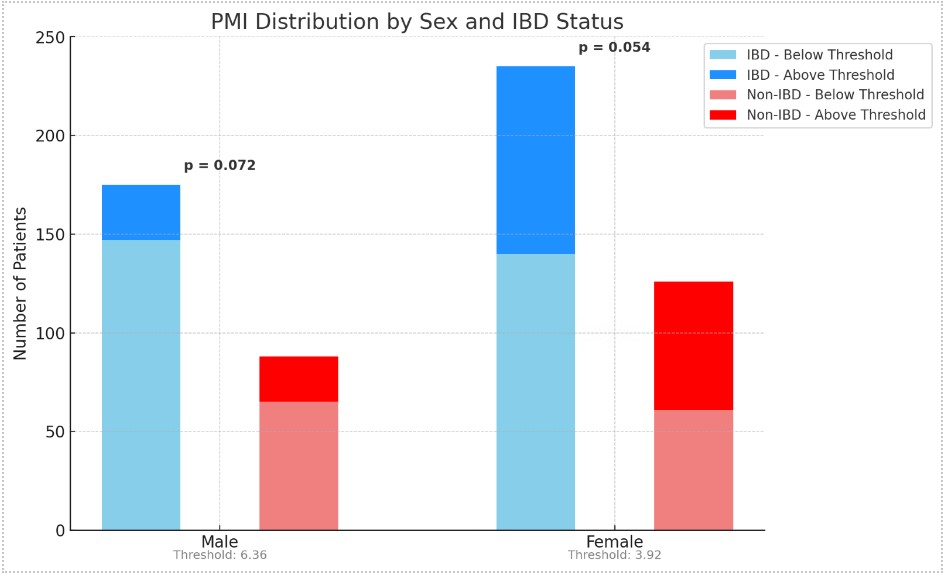Sunday Poster Session
Category: IBD
P1061 - Decreased Muscle Mass and Sarcopenia in Patients With Inflammatory Bowel Disease
Sunday, October 26, 2025
3:30 PM - 7:00 PM PDT
Location: Exhibit Hall
- TL
Tayna Latortue, MD (she/her/hers)
University of Florida
Gainesville, FL
Presenting Author(s)
Tayna Latortue, MD, Abdillahi Ahmed, MD, Yasmeen Saker, MD, Eddie Velazquez, MD, Megan Horwitz, BS, Amir Kamel, PharmD
University of Florida, Gainesville, FL
Introduction: Inflammatory bowel disease (IBD), encompassing ulcerative colitis and Crohn’s disease, is characterized by chronic gastrointestinal inflammation. It is frequently complicated by malnutrition due to malabsorption, diarrhea, vomiting, and poor oral intake. Over time, this may lead to sarcopenia, a condition of skeletal muscle wasting associated with impaired wound healing, increased frailty, and higher mortality. The study aimed to evaluate the prevalence of sarcopenia in patients with IBD compared to those without IBD.
Methods: We conducted a retrospective chart review of 1,102 patients with ICD-10 codes for ulcerative colitis or Crohn's disease at the University of Florida, covering the period from January 2013 to June 2017. The electronic medical records for these patients were manually reviewed to confirm a diagnosis of IBD based on biopsy and imaging, or to confirm the absence of IBD. Demographic data, C-reactive protein levels, and disease severity were recorded. Cross-sectional abdominal computed tomography (CT) images at the L3 vertebral level were analyzed using Slice-O- Matic software to measure psoas muscle surface area (cm2). This value was normalized by patient height (m2) to calculate the psoas muscle index (PMI). Sarcopenia was defined as a PMI < 6.36 cm2/m2 for males and < 3.92 cm2/m2 for females. Group comparisons were conducted using t-tests and chi-square tests, with statistical significance set at < 0.05.
Results: A total of 1,102 patients were reviewed. Of these, 492 were excluded due to the absence of cross-sectional CT imaging. This left 395 patients with both CT imaging and IBD, and 215 with CT imaging but without IBD. The mean PMI in the IBD group was significantly lower than in the non-IBD group (2.84 cm2/m2 vs. 4.50 cm2/m2; p < 0.0001). Among males, sarcopenia was present in 84% of patients with IBD and 87% of those without IBD (p = 0.072). Among females, sarcopenia was present in 60% of patients with IBD compared to 48% of those without IBD (p = 0.054).
Discussion: Patients with IBD demonstrate significantly lower muscle mass compared to patients without IBD. However, when stratified by sex, this difference in sarcopenia prevalence does not reach statistical significance. These findings highlight the importance of muscle loss in patients with IBD, as sarcopenia is associated with adverse outcomes including frailty, falls, and prolonged hospitalization.

Figure: Bell curve comparing average PMI amount patients with IBD versus patients without IBD

Figure: 1. Bar chart comparing PMI meeting sarcopenia threshold by sex and IBD status
Disclosures:
Tayna Latortue indicated no relevant financial relationships.
Abdillahi Ahmed indicated no relevant financial relationships.
Yasmeen Saker indicated no relevant financial relationships.
Eddie Velazquez indicated no relevant financial relationships.
Megan Horwitz indicated no relevant financial relationships.
Amir Kamel indicated no relevant financial relationships.
Tayna Latortue, MD, Abdillahi Ahmed, MD, Yasmeen Saker, MD, Eddie Velazquez, MD, Megan Horwitz, BS, Amir Kamel, PharmD. P1061 - Decreased Muscle Mass and Sarcopenia in Patients With Inflammatory Bowel Disease, ACG 2025 Annual Scientific Meeting Abstracts. Phoenix, AZ: American College of Gastroenterology.
University of Florida, Gainesville, FL
Introduction: Inflammatory bowel disease (IBD), encompassing ulcerative colitis and Crohn’s disease, is characterized by chronic gastrointestinal inflammation. It is frequently complicated by malnutrition due to malabsorption, diarrhea, vomiting, and poor oral intake. Over time, this may lead to sarcopenia, a condition of skeletal muscle wasting associated with impaired wound healing, increased frailty, and higher mortality. The study aimed to evaluate the prevalence of sarcopenia in patients with IBD compared to those without IBD.
Methods: We conducted a retrospective chart review of 1,102 patients with ICD-10 codes for ulcerative colitis or Crohn's disease at the University of Florida, covering the period from January 2013 to June 2017. The electronic medical records for these patients were manually reviewed to confirm a diagnosis of IBD based on biopsy and imaging, or to confirm the absence of IBD. Demographic data, C-reactive protein levels, and disease severity were recorded. Cross-sectional abdominal computed tomography (CT) images at the L3 vertebral level were analyzed using Slice-O- Matic software to measure psoas muscle surface area (cm2). This value was normalized by patient height (m2) to calculate the psoas muscle index (PMI). Sarcopenia was defined as a PMI < 6.36 cm2/m2 for males and < 3.92 cm2/m2 for females. Group comparisons were conducted using t-tests and chi-square tests, with statistical significance set at < 0.05.
Results: A total of 1,102 patients were reviewed. Of these, 492 were excluded due to the absence of cross-sectional CT imaging. This left 395 patients with both CT imaging and IBD, and 215 with CT imaging but without IBD. The mean PMI in the IBD group was significantly lower than in the non-IBD group (2.84 cm2/m2 vs. 4.50 cm2/m2; p < 0.0001). Among males, sarcopenia was present in 84% of patients with IBD and 87% of those without IBD (p = 0.072). Among females, sarcopenia was present in 60% of patients with IBD compared to 48% of those without IBD (p = 0.054).
Discussion: Patients with IBD demonstrate significantly lower muscle mass compared to patients without IBD. However, when stratified by sex, this difference in sarcopenia prevalence does not reach statistical significance. These findings highlight the importance of muscle loss in patients with IBD, as sarcopenia is associated with adverse outcomes including frailty, falls, and prolonged hospitalization.

Figure: Bell curve comparing average PMI amount patients with IBD versus patients without IBD

Figure: 1. Bar chart comparing PMI meeting sarcopenia threshold by sex and IBD status
Disclosures:
Tayna Latortue indicated no relevant financial relationships.
Abdillahi Ahmed indicated no relevant financial relationships.
Yasmeen Saker indicated no relevant financial relationships.
Eddie Velazquez indicated no relevant financial relationships.
Megan Horwitz indicated no relevant financial relationships.
Amir Kamel indicated no relevant financial relationships.
Tayna Latortue, MD, Abdillahi Ahmed, MD, Yasmeen Saker, MD, Eddie Velazquez, MD, Megan Horwitz, BS, Amir Kamel, PharmD. P1061 - Decreased Muscle Mass and Sarcopenia in Patients With Inflammatory Bowel Disease, ACG 2025 Annual Scientific Meeting Abstracts. Phoenix, AZ: American College of Gastroenterology.
